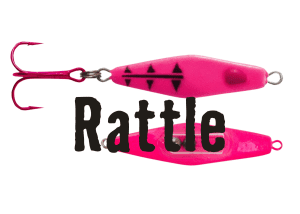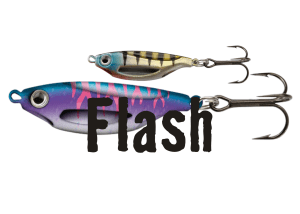Rattle & Flash Jigging Spoons
When you first drop your line – what is your bait delivery system?
There is no question that we all have a pile of jigging spoons in our tackle boxes! Whether you purchased them because you wanted a few from each of the vast options of colors, brands,
or styles – one thing is certain, we can all narrow down our favorite one that we line drop with at the beginning of the day. Sometimes your go-to is your “lucky jig”, the tried & true & works every time jig.
For some anglers, they are out to try the newest release jig, and for others, it’s simply using whatever you hear is working for a friend that day.
Whatever your method is for selecting your spoon of choice, the right one is always going to be, what draws in the fish! With all the different types of jigging spoons out there – Do you know the differences between each one of them and the design?
It can be pretty overwhelming as you start developing routines of when it’s time to reach for which one.
For now, we’re going to cover the differences between using a rattle and a flash jigging spoon for initial line drops to draw attention and bring the fish to your radar.
Start your day with a rattle jigging spoon. Rattles are used to make noise and vibration in the water to bring attention and bring fish in from a distance.
Used for vertical jigging perch, walleye, trout, pike, and bass. While using this spoon you need to be jigging aggressively in a lift-fall manner to call fish from a wide radius.
Once the fish are drawn in – be cautious about how aggressive you are jigging as the noise could be a deterrent once the fish are close.
Tip this jig with a minnow head, or waxworms.
Give the fish what they want. Start aggressive and call them in, but then it’s important to watch their mood. If the rattle jig is too aggressive after you have called in the attention of the fish,
changing your jigging presentation may be the next step to getting the fish to bite.
Now is the time to change over to a flash jigging spoon. You will have to do the work with this jig, many pro fishermen say they will tip this jig with
live bait and then choose a color jig that mimics the current underwater
surroundings. From there, they will experiment with other brighter colors if the fish are not showing interest. It’s important to watch the fish’s mood and be
willing to change to different colors to peak their interest.
Tip this jig with a minnow head or waxworms.
Check out this video where Ice Fishing Guide Joel Nelson, shares his initial go-to spoons and strategies in picking his first jigging spoon of the day.
Although both may eventually get the attention you’re looking for, the fish may still snub your presentation. So it’s always good to have alternative solutions if you are not drawing interest.
The take away from Joel’s video and our tip of the day could be summed up with one statement:
“Start with a rattle spoon – if they are snubbing it – go with a more finesse presentation with a flash.” Joel Nelson


